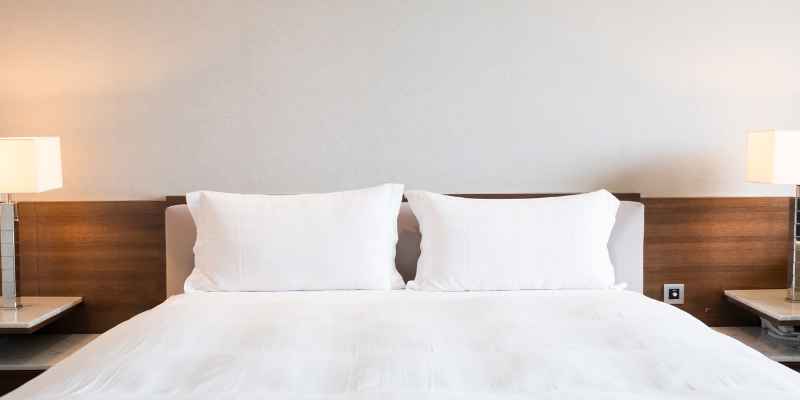To make bed slats stronger, reinforce them with additional support or replace them with thicker slats. By adhering to these guidelines, you can effectively strengthen your bed slats for improved stability and durability.
Having a strong and sturdy bed is essential for a good night’s sleep. However, over time, bed slats can wear out or become less supportive, leading to discomfort and potential damage to the mattress. Strengthening bed slats is crucial to maintain the structural integrity of your bed frame and ensure a restful sleeping experience.
We will discuss some practical tips and techniques for reinforcing bed slats, allowing you to enjoy a more comfortable and durable bed setup. Whether you are dealing with wooden slats or metal ones, these methods can help you enhance their strength and stability with minimum effort and expense.
Why Bed Slats Matter
Bed slats play a vital role in ensuring the strength and stability of your bed. Learn effective techniques to reinforce and make bed slats stronger for better support and durability.
Bed slats are the often overlooked but essential component of any bed frame. They play a crucial role in providing the necessary support for your mattress, ensuring a comfortable and restful sleep. A weak or damaged bed slat can lead to sagging, discomfort, and even structural issues with your bed frame. In this section, we’ll explore the importance of strong bed slats and provide tips on choosing the right ones for your bed.
Choosing The Right Bed Slats
When it comes to choosing bed slats, there are a few factors to consider. The size and weight of your mattress, as well as your personal preferences for firmness, should guide your decision. Here are some tips to help you choose the right bed slats:
- Measure your bed frame accurately to ensure the slats will fit properly.
- Opt for slats made from durable materials such as solid wood or metal for enhanced strength and longevity.
- Consider the spacing between the slats. For optimal support, the gaps should be minimal, typically no more than 3-4 inches apart.
- Look for slats with sufficient thickness to withstand the weight of the mattress and the sleeper. Thicker slats provide better support and have a lower risk of bending or breaking.
- Take into account any specific needs or preferences you have, such as adjustable slats for personalized comfort.
The Importance Of Strong Bed Slats
Strong bed slats are essential for several reasons. Firstly, they distribute the weight of the mattress and the person sleeping on it evenly, reducing any excess strain on the bed frame. This helps prevent damage to the frame and ensures its longevity. Secondly, sturdy slats provide proper support for your mattress, preventing sagging and maintaining its shape over time. This is particularly important for foam or memory foam mattresses that rely on even support to provide optimal comfort. Lastly, robust bed slats enhance the overall stability of your bed, minimizing the risk of accidents or structural issues.

Assessing And Reinforcing Bed Slats
When it comes to ensuring a comfortable and sturdy bed frame, the strength of bed slats plays a crucial role. Over time, bed slats can weaken due to heavy usage or inadequate quality. To maintain the longevity of your bed and prevent sagging, it is essential to assess and reinforce the bed slats. In this article, we will discuss the process of identifying weak points in bed slats and explore various methods for strengthening them. Let’s dive in and discover how to make bed slats stronger!
Identifying Weak Points
Before you can begin reinforcing your bed slats, it’s vital to identify the weak points that are causing the sagging or instability. Here are some common indicators to look out for:
- Sagging in the middle or at specific areas
- Cracks or splits in the slats
- Bowing or bending of the slats
- Noise or creaking sounds while getting in and out of bed
If you notice any of these signs, it’s likely that your bed slats require reinforcement. Assessing the weak points accurately will help you determine the most suitable method for strengthening your bed slats.
Methods For Strengthening Bed Slats
Once you have identified the weak points, there are several effective methods you can use to reinforce your bed slats.
1. Adding Support Brackets
One common method for strengthening bed slats is by adding support brackets beneath the slats. These brackets help distribute the weight evenly, reducing strain on individual slats and preventing sagging. Support brackets can be easily installed using screws or nails, providing additional stability to your bed frame.
2. Using Metal Reinforcements
If your bed slats are made of wood, metal reinforcements can significantly enhance their strength and durability. Metal angle brackets or L-shaped brackets can be attached to the corners of each slat, preventing them from bowing or bending. This method ensures that your bed slats remain resilient and capable of supporting weight without compromising their structural integrity.
3. Upgrading to Thicker Slats
If your existing slats are too thin or worn out, consider upgrading to thicker slats. Thicker slats provide better support and reduce the chances of sagging or breakage. Look for slats made from quality hardwood like oak or maple, as they are known for their strength and durability. Remember to measure the dimensions of your bed frame before purchasing the new slats to ensure a proper fit.
4. Reinforcing with Plywood
In cases where your bed slats are beyond repair, reinforcing them with plywood can be a viable solution. By placing a layer of plywood over the slats, you create a solid surface that evenly distributes the weight and eliminates any weak points. Ensure that the plywood is cut to the correct size and securely attached to the slats using screws or adhesive.
By assessing the weak points in your bed slats and implementing one or more of these methods for reinforcement, you can effectively increase the strength and stability of your bed frame. Don’t let sagging slats disrupt your sleep – take action today and enjoy a comfortable and robust bed!
Alternative Bed Slat Materials
When it comes to making bed slats stronger, exploring alternative materials can be an effective solution. By opting for different types of bed slats, you have the opportunity to enhance the durability and stability of your bed frame. In this section, we will take a closer look at the various materials you can consider for your bed slats, weighing their pros and cons to help you make an informed decision.
Exploring Different Types Of Bed Slats
There are several alternative materials available for bed slats, each offering unique characteristics to improve the overall strength of your bed. Let’s explore some popular options:
Pros And Cons Of Alternative Materials
Before making a decision, it’s crucial to assess the pros and cons of using alternative materials for bed slats. Let’s delve into the advantages and disadvantages of the different types:
| Material | Pros | Cons |
|---|---|---|
| 1. Metal |
|
|
| 2. Plywood |
|
|
| 3. Bamboo |
|
|
By considering the pros and cons of each alternative material, you can make an informed decision based on your priorities and requirements. Don’t forget to keep your budget and personal preferences in mind as well.
Maintaining And Caring For Bed Slats
To maintain and care for bed slats, it is important to make them stronger. Reinforcing them with additional support or upgrading to stronger materials can extend their lifespan and prevent sagging. Regular inspections and cleaning also play a vital role in ensuring the durability and longevity of bed slats.
Preventing Sagging And Warping
Proper maintenance and care are essential to keep your bed slats strong and prevent sagging and warping. With regular attention, you can extend the lifespan and durability of your bed slats, ensuring a comfortable and supportive sleep surface.
1. Adjust Slats Regularly
Check your bed slats periodically and adjust them if necessary. Over time, slats may shift or become loose, which can contribute to sagging. By tightening or repositioning the slats, you can ensure they remain properly aligned and provide optimal support.
2. Reinforce Weak Areas
If you notice any weak areas on your bed slats, you can reinforce them to prevent further damage. Using metal braces or additional wooden supports, such as plywood, can help distribute the weight evenly and strengthen the weak spots.
3. Use Slats of Adequate Size and Thickness
When replacing or upgrading your bed slats, make sure to choose slats that are appropriate for your bed frame. Opt for slats that are of adequate size and thickness to withstand the weight and pressure of your mattress and body.
Cleaning And Properly Supporting Bed Slats
To maintain a clean and supportive sleep environment, it’s essential to clean and properly support your bed slats. Here are some tips to keep them in top condition:
1. Regular Cleaning
Dust and debris can accumulate on the bed slats over time, affecting their performance and longevity. Regularly clean the slats using a vacuum cleaner or a damp cloth to remove any dirt, dust, or allergens that might have settled between the gaps.
2. Proper Mattress Support
Ensure that your mattress is properly supported by the bed slats. Use a mattress pad, topper or a thin layer of plywood to distribute weight more evenly and prevent excessive pressure on individual slats.
3. Use a Bed Frame with Center Support
If you have a larger or heavier mattress, it’s important to use a bed frame with a center support beam. This support beam helps distribute the weight evenly across the slats, minimizing the risk of sagging or breaking.
By following these tips, you can maintain and care for your bed slats effectively, preventing sagging, warping, and other issues.
Enhancing Bed Slats For Optimal Sleep
Getting a good night’s sleep is essential for our overall well-being, and the quality of our bed and mattress plays a crucial role in achieving that. One important component of a bed frame that often goes overlooked is the bed slats. These horizontal wooden or metal supports provide the foundation for our mattress, ensuring stability and support. However, over time, bed slats can become weak or noisy, leading to discomfort and disrupted sleep. In this article, we will explore some simple yet effective ways to enhance bed slats for optimal sleep, focusing on adding ergonomic features and incorporating noise reduction techniques.
Adding Ergonomic Features
When it comes to enhancing bed slats, adding ergonomic features can significantly improve both comfort and support. Ergonomics is the science of designing products to fit the natural movement and posture of the human body, reducing strain and promoting optimal alignment. By incorporating ergonomic features into your bed slats, you can create a sleep surface that adapts to your body’s contours and provides maximum support. Here are some tips to make your bed slats more ergonomic:
- Consider using adjustable or flexible bed slats that allow you to customize the firmness and support levels according to your needs and preferences.
- Ensure the spacing between slats is appropriate. Generally, a gap of 2-3 inches between slats is ideal to provide proper support without sagging.
- Choose bed slats made from high-quality materials such as solid wood or sturdy metal, which offer better durability and support than low-quality alternatives.
- Check the width and thickness of the bed slats. Thicker slats tend to be more robust and less likely to bend or break under weight.
- If your bed slats are already in good condition, adding a mattress topper or padding can further enhance comfort and support, improving the overall sleep experience.
Incorporating Noise Reduction
Another common issue with bed slats is noise. Over time, bed slats can start to squeak or creak, causing disturbances during sleep and affecting the overall sleep quality. Incorporating noise reduction techniques can help eliminate or minimize these noises, ensuring a peaceful and restful sleep environment. Here are some effective ways to reduce noise in bed slats:
- Apply a thin layer of lubricant such as silicone spray or furniture wax on the contact points between the bed slats and the bed frame. This helps reduce friction and prevents squeaking.
- Tighten any loose screws or bolts that connect the bed slats to the bed frame. Loose connections can create unnecessary movement and noise.
- Consider using rubber or foam padding between the slats and the bed frame. This can help absorb vibrations and reduce noise caused by the rubbing of materials.
- Inspect the bed frame for any worn-out or damaged parts that may be causing the noise. Replace or repair these components as necessary.
By following these tips and incorporating ergonomic features and noise reduction techniques, you can significantly enhance your bed slats and ensure a peaceful and comfortable sleep environment. Remember, a well-supported and noise-free bed promotes better sleep, allowing you to wake up refreshed and rejuvenated every morning.

Frequently Asked Questions Of How To Make Bed Slats Stronger
How Can I Make My Slatted Bed Stronger?
To make your slatted bed stronger:
1. Use thicker slats for added support.
2. Consider adding extra slats to distribute weight evenly.
3. Reinforce the frame with brackets or additional support beams.
4. Ensure proper spacing between slats to prevent sagging.
5. Use a sturdy central support leg for added stability.
Can You Put Plywood Over Bed Slats?
Yes, you can place plywood over bed slats. It provides extra support and stability for the mattress. However, ensure the plywood is smooth and doesn’t have any protruding edges to prevent damage to the mattress.
Why Do My Bed Slats Keep Breaking?
Bed slats may keep breaking due to several factors like poor quality material, improper installation, excessive weight or pressure, regular wear and tear, or lack of support in the bed frame. Consider replacing the slats with sturdier ones, ensuring proper weight distribution, and checking the bed frame for any structural issues.
How Much Weight Can Bed Slats Hold?
Bed slats can typically hold a weight of around 500 to 600 pounds, depending on the size and material used. Stronger slats made of solid wood or metal are more capable of supporting heavier weights, ensuring a sturdy and reliable bed frame for comfortable sleep.
Conclusion
To sum up, by following these simple steps, you can easily make your bed slats stronger and prevent them from sagging or breaking. Start by choosing the right type of material, ensuring proper spacing, and adding additional support if needed.
Regular maintenance and timely repairs will prolong the lifespan of your bed slats, providing you with a sturdy and reliable sleeping surface. So go ahead and try out these tips to improve the strength and stability of your bed slats and enjoy a more comfortable and restful sleep.


